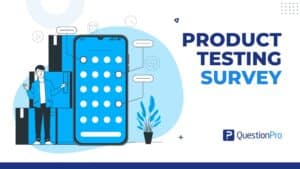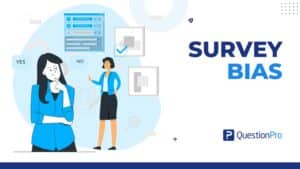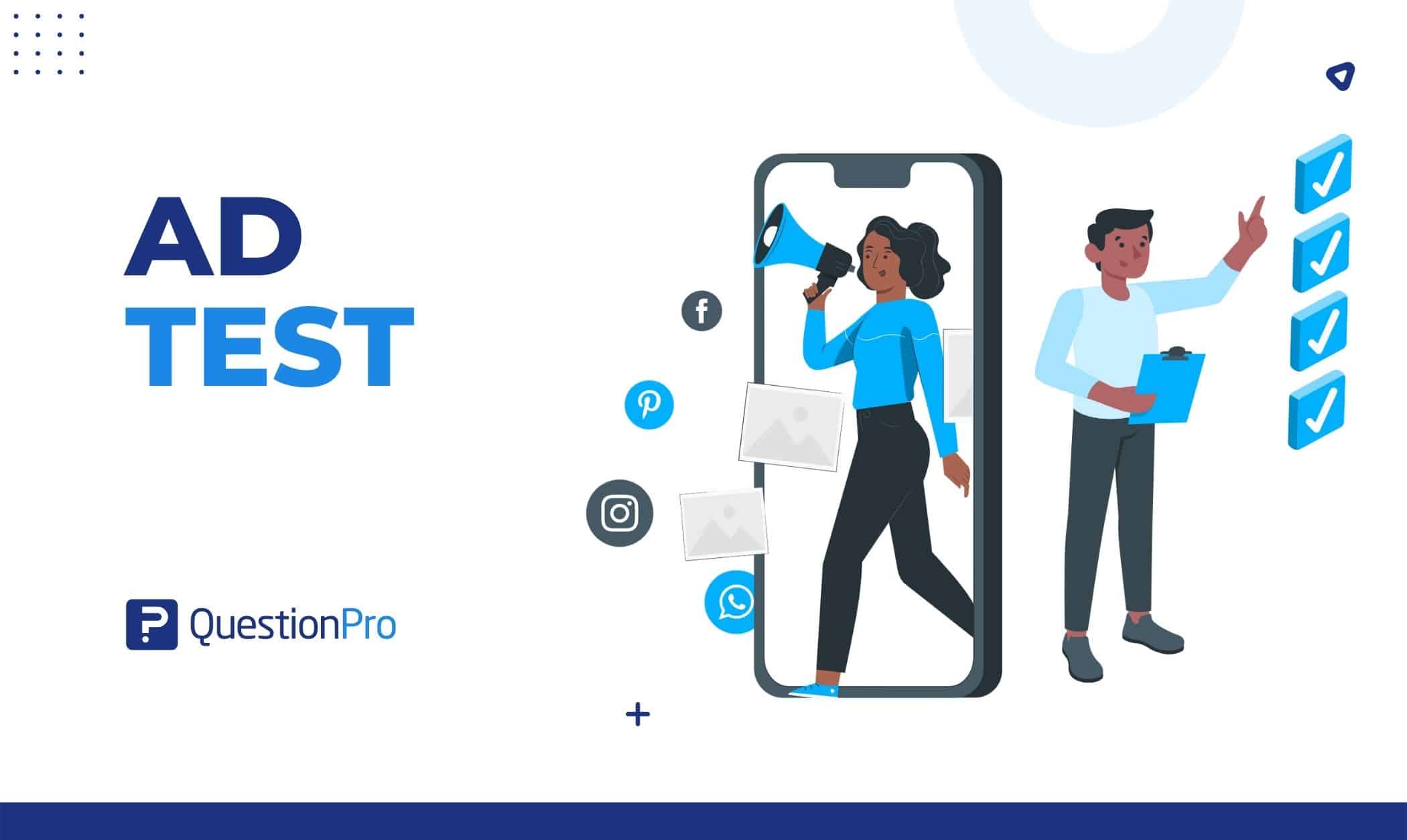
Ads remain one of the most crucial components of an overall advertising strategy. A potential customer only sees advertisements as part of your marketing campaigns. Ad preferences and demographics instruct the Ad platform on whether and how often to show your ads.
Market research technique like ad testing is used to evaluate the success of advertising efforts. Testing advertisements allows businesses to see how people will react to specific messages and adjust accordingly. It significantly improves your advertising account, including conversion rates, cost per conversion, ad quality, and more.
QuestionPro Research Suite is an automated market research platform and creative testing software designed for insights professionals, market researchers, and agencies who want to test, learn, and move faster. This agile insights platform uses AI, Machine Learning, and Meta Data to customize research for you and your audience and mine data insights.
When marketers don’t have a clear idea of what they want to test and how to choose data-focused winning criteria, they are more likely to make mistakes in their ad testing. This blog will show you what ad testing is and how to run one.
What is ad testing?
Ad testing is the process of analyzing your ad concepts with a sample of your target market. You may run tests on a complete ad or just certain parts of it to get feedback on how much the ad sticks out and how the targeted audience finds it.
What components of your adverts should you test? It will be easier for you to create your discussion guide if you know the elements you want to emphasize. There are several possibilities for the components you choose to test, including:
- Fresh calls-to-action (CTA)
- Updated headlines
- New description
- New pictures
- Landing pages
- Etc.
Benefits of ad testing
Running ads costs money. Companies invest heavily in bringing their unique concept to reality, then spend even more money spreading the word. Consequently, they require advertising efforts that are powerful, extensive, and attractive. Significant benefits of using testing to determine the effectiveness of advertising include:
- It provides information so that you can make informed judgments. You should have no trouble convincing coworkers to use the most significant ad concepts if you can demonstrate which ones they are.
- It offers suggestions for more advancements. You have the opportunity to improve your already appealing copy with this feedback!
- It helps you learn about your customers and divide them into distinct groups. You may filter replies to discover how different groups feel about your adverts. These data might help you create ads for specific groups or a single ad that appeals to all.
- This capacity characterizes agile market research. It helps your business make changes fast. It allows your team to become more self-reliant in decision-making and reduces its reliance on other sources for information.
Drawbacks of ad testing
The method of ad testing has many drawbacks, even though it excels in other areas. Take a look at this:
- It requires a lot of available resources. If you pay your employees on an hourly basis, ad testing will put a significant strain on your budget.
- If you make a mistake, it could damage your reputation. The effects on viewers who have seen that advertisement will be the same as if you made a mistake during the live campaign.
- It reveals your activities to your competitors. If the ads you’re testing are visible to your audience, your competitors can also see them. Leaking anything that is still being developed is not the best idea.
Types of ad testing you can run
There is no one optimum approach to conduct your ad testing because it depends on your situation. Generally, you may categorize ad testing methods into in-market and survey testing.
01. In-market testing
In-market ad testing involves trial runs with controllable variables. Based on the outcomes of these variants, you may determine the most effective mix of ad elements and then allocate the rest of your cash there. In-market ad testing can be done in various methods; the most popular are:
- A/B testing: A/B testing compares two copies of your advertisement while adjusting one factor to see which one performs better.
- Multivariate ad testing: It is similar to A/B testing but increases the number of versions. Any mobile ad has variables such as on-image text, CTA, location, color selections, and graphics. Multivariate ad testing can modify multiple factors at once to find the optimum combination.
02. Survey testing
Survey testing differs from in-market testing because no advertisements need to be run here. You can gather the comments from your respondents, which can be turned into data and valuable insights. Monadic and sequential monadic testing are two different survey testing types.
- Monadic ad testing: The advertisement in a monadic test could come in various forms. You need a sizable sample size of responders to obtain significant findings from your test on a wide range of ad versions. The survey asks each respondent to give feedback after viewing one single ad on its own.
- Sequential monadic ad testing: Sequential monadic ad testing is an alternative to monadic ad testing. You will ask similar questions because the underlying idea is the same. But you can ask for their opinions on several different ad variants, one after the other, rather than just one for each survey respondent.
Implementing Effective Advertising Testing
To make sure your marketing campaigns work well, you need to test your ads effectively. Here are some simple steps to help you improve your ads and make them more appealing to your target audience:
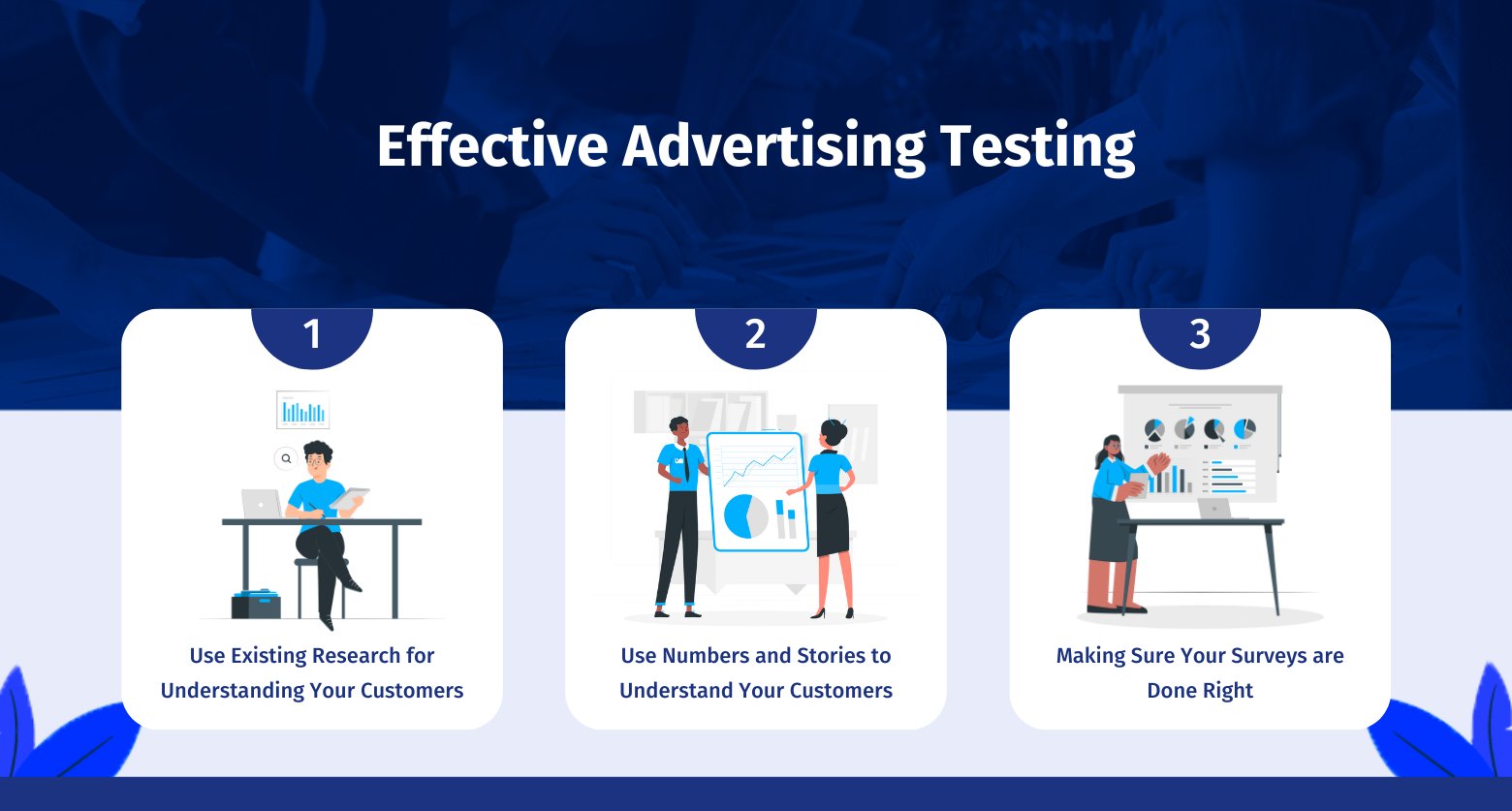
Using Existing Research for Understanding Your Customers
Before you start testing your ads, use any research you already have to learn more about your customers. Find out what they like, how they shop, and what interests them. This will help you make better decisions about your ads.
- Look at previous research reports.
- Check out studies on customer behavior.
- Use data from your past ad campaigns.
Using Numbers and Stories to Understand Your Customers Better
To really understand what your customers want, you need to collect both numbers and stories.
- Use numbers to see trends and patterns.
- Use stories to better understand your customers’ thoughts and feelings.
Making Sure Your Surveys are Done Right
When you test your ads, it’s important to do surveys in the right way. This means making sure your surveys are fair and reliable.
- Mix up the questions so they’re fair.
- Use different versions of your ads to see which ones work best.
- Make sure your surveys are easy to understand.
How to run ad testing?
Ad testing is comparing several ad campaigns with different representations of your target audience and seeking input. You can decide to run ad tests on a complete advertisement or just a portion of it. Feedback will be gathered on anything from how much the ad stands out to how inspired people were to buy the product it is advertising.
Ad testing begins with concept development, but it can be hard to make the perfect ad. If you’re now ready to start testing your ads, here are some steps you must take:
01. Select the ads you want to test
Your advertisements may consist of videos, photos, text, audio, or a combination of these components. As you choose the structure for your promotions, you should also examine their content in light of where they will be displayed. For instance, you may want to target professional networkers using Linkedin advertisements rather than Facebook ads or Google search ads.
02. Choose your metrics
You should be able to determine what distinguishes one advertisement from another based on the factors you measure. The following should be considered essential advertising metrics:
- Attract: Is your advertisement’s visual and messaging appealing?
- Authenticity: Does the information in your advertisement appear authentic?
- Purchase motivation: Will your advertisement inspire customers to acquire your product or service?
- Importance: Does the ad meet the requirements and desires of your target audience?
- Diversity: Does your advertisement stand out from the competition?
Therefore, it isn’t easy to generalize how much importance various metrics should be given.
For instance, if you want to make sure that your brand stands out from the competition, then being original can be more important. However, if increasing revenue is your number one priority, measuring consumer intent to buy may be more crucial.
03. Survey your target audience
After your intended audience has had a chance to review your advertisements, you will know how effective they were. You need to select your participants and allow them to provide feedback on your adverts. Both of the following are standard methods:
- Focus groups: Using this method, you can effectively gather detailed responses to numerous questions. It is a fantastic opportunity to get feedback from consumers and prospective buyers. Focus groups can help collect information about your target audience, but they can be time-consuming and expensive to set up.
- Online Surveys: Using an online survey platform, you can quickly and easily get input from a targeted audience of your choosing. Although you can survey more individuals for less money with this method, you may not get as in-depth feedback as with a focus group.
Platforms like QuestionPro make interacting with and collecting external and internal data from your target audience easy.
Combine different types of questions into your survey. Keep the tone objective, use only the number of words required to convey the idea, and leave away any descriptive or emotional language that could influence the reader’s reaction.
04. Choose the best ad from the results
After gathering data, you can evaluate the advertising with one another. Maintaining accurate survey information records is crucial to this stage’s success. You can divide your report into general conclusions and specific results from each advertisement.
Your general conclusions will show which advertisements generated the best initial responses and are most likely to increase sales. You can delve deeper into the specifics of each ad to find any weak points by conducting an individual ad analysis.
Measuring How Well Your Ads Work
It’s important to know if your ads are working well. Here are some ways to measure their success:
Testing Your Ads with Different Groups
One way to see if your ads are working is to test them with different groups of people.
- Divide your customers into different groups.
- Show each group a different version of your ad.
- Ask them what they think.
Keeping an Eye on Important Numbers
Another way to measure your ads’ success is to keep track of important numbers, like:
- How many people know about your brand.
- How many people are thinking about buying your product.
- How much your sales go up after the ad campaign.
By keeping an eye on these numbers, you can see if your ads are working well and make changes if you need to.
Why Choose QuestionPro as Ad Testing Software?
Ad Testing Survey Software helps assess how well ads work in different product life stages. It’s used to study how people react to ads by showing them to the right audience. This software is crucial for gathering feedback early on and saving money on ads.
Having the right ad testing software is crucial for optimizing your advertising campaigns. Whether you’re launching new campaigns or refining existing ones, QuestionPro provides all the ad testing tools you need to succeed.
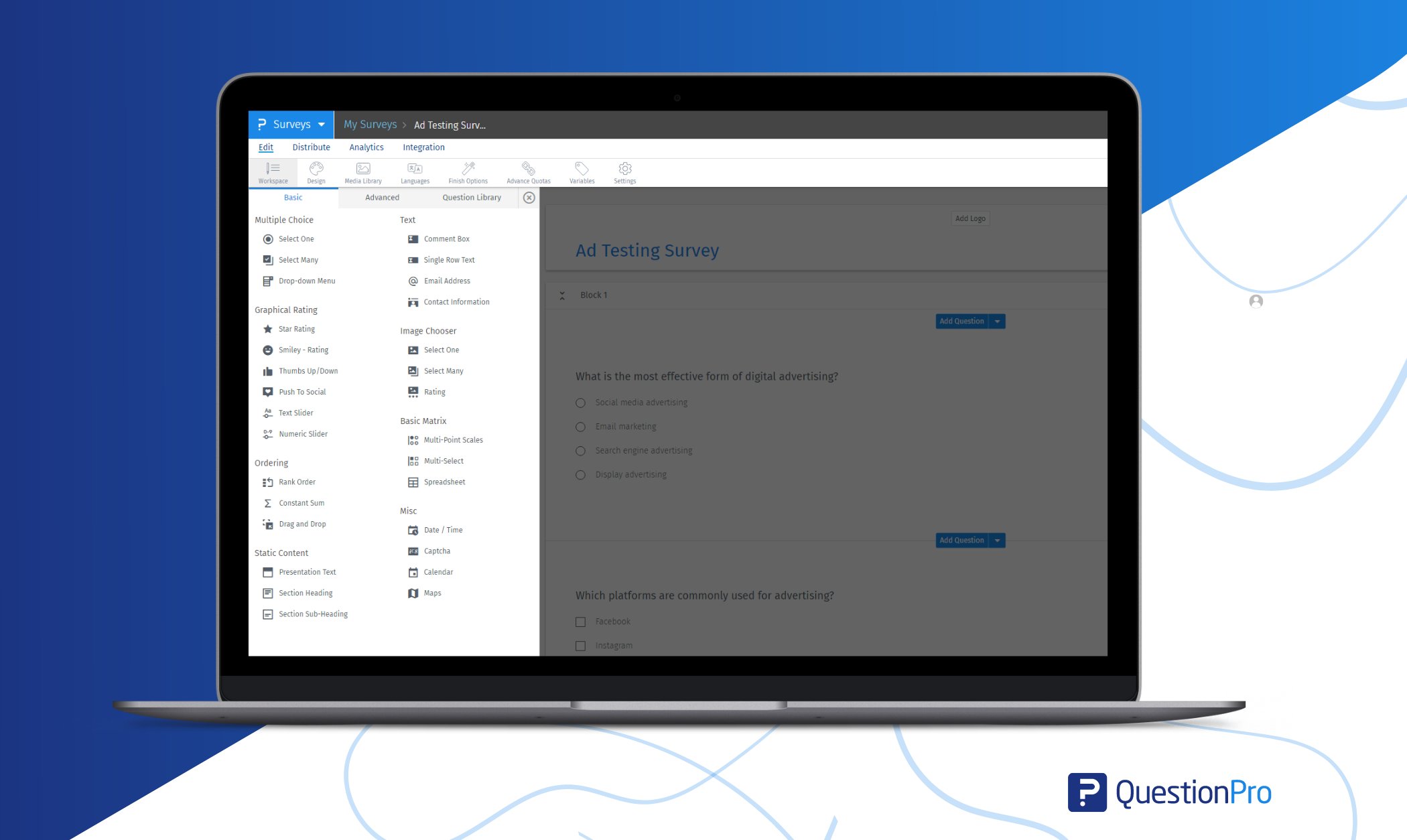
Here’s why QuestionPro survey software stands out as the best ad testing tool:
1. Comprehensive Ad Testing Features
- Test ads, validate advertising concepts and creative testing executions with ease.
- Identify which print, video, and digital ads resonate with your target audience.
- Predict the effect on purchase intent and understand how your brand is perceived.
- Pre-made customizable survey templates.
- Get the highest ROI for your ad spend.
2. Versatile Ad Evaluation
- Evaluate all ads and ad copy types, from audio and video files to text and image concepts, without switching between different tools.
3. Audience Engagement and Multi-channel Distribution
- Engage your audience on their terms with multi-channel distribution.
- Reach your audience anytime, anywhere, from emails to mobile to social.
4. Instant Ad Sentiment Analysis
- Discover ad sentiment instantly and save time through automation.
- Leverage advanced text analytics to understand key topics and sentiment.
5. Easy Survey Design and Advanced Analytics
- Design your ad testing survey with an intuitive interface.
- Utilize 100+ question types to customize your respondents’ survey experience.
- Instantly understand overall reactions and impressions of your ad with advanced text analytics.
6. Instant Respondent Generation
- Instantly find respondents for your ad testing, whether you need basic demographic or specific audience criteria.
Conclusion
Advertising is key to building your brand and making your business successful if you do it right. You may be secure in your work and unwind, knowing that your days of producing useless advertisements are over now that you have the steps to conduct and test your advertising campaigns.
If you want something more sophisticated than essential survey software, QuestionPro is an excellent solution. You will be able to start gathering information after they receive your questionnaires.
On QuestionPro, you’ll discover every tool you require for research. With QuestionPro’s professional solutions, you can begin running ads tests right away!




